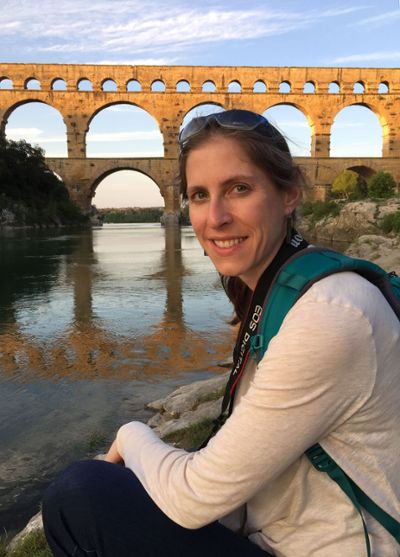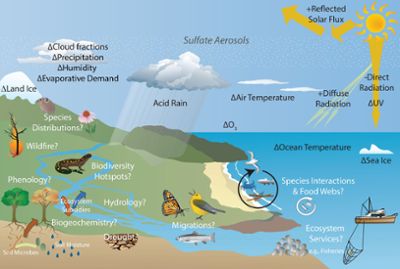To intervene or not to intervene? That is the future climate question
Nine of the hottest years in human history have occurred in the past decade. Without a major shift in this climate trajectory, the future of life on Earth is in question, which poses a new question: should humans, whose fossil fueled society is driving climate change, use technology to put the brakes on global warming?
Michigan State University community ecologist Phoebe Zarnetske is co-lead of the Climate Intervention Biology Working Group, a team of internationally recognized experts in climate science and ecology that is bringing science to bear on the question and consequences of geoengineering a cooler Earth.

The group’s seminal paper, “Potential ecological impacts of climate intervention by reflecting sunlight to cool Earth,” was published in the most recent issue of Proceedings of the National Academy of Sciences of the United States (PNAS).
“There is a dearth of knowledge about the effects of climate intervention on ecology,” said Zarnetske, associate professor in the Department of Integrative Biology in the MSU College of Natural Science and the paper's lead author. “As scientists, we need to understand and predict the positive and negative effects it could have on the natural world, identify key knowledge gaps, and begin to predict what impacts it may have on terrestrial, marine and freshwater species and ecosystems if it were adopted in the future.”
Conversations in 2018 between Jessica Gurevitch, Distinguished Professor in the Department of Ecology and Evolution at Stony Brook University and working group co-lead, and Alan Robock, Distinguished Professor in the Department of Environmental Sciences at Rutgers University, gave rise to the pioneering group, which is more aware than most that geoengineering Earth’s atmosphere is more than just a science-fiction scenario.

The costs and technology needed to reflect the sun’s heat back into space are currently more attainable than other climate intervention ideas like absorbing carbon dioxide (CO2) from the air. The working group anticipates their lively discussions and open access paper will encourage an explosion of scientific investigation into how a climate intervention strategy known as solar radiation modification (SRM), in tandem with greenhouse gas emissions reduction, would affect the natural world.
The feasibility of planetary-wide SRM efforts hinge on accurate predictions of its myriad outcomes provided by the well-established computer simulations of the Geoengineering Model Intercomparison Project (GeoMIP). The PNAS paper lays the foundation for expanding GeoMIP’s scope to include the incredible range and diversity of Earth’s ecosystems.
“While climate models have become quite advanced in predicting climate outcomes of various geoengineering scenarios, we have very little understanding of what the possible risks of these scenarios might be for species and natural systems,” Gurevitch explained. “Are the risks for extinction, species community change and the need for organisms to migrate to survive under SRM greater than those of climate change, or does SRM reduce the risks caused by climate change?”

“Most of the GeoMIP models only simulate abiotic variables, but what about all of the living things that are affected by climate and rely on energy from the Sun?” added Zarnetske, who is also an Ecology, Evolution, and Behavior program faculty member. “We need to better understand the possible impacts of SRM on everything from soil microorganisms to monarch butterfly migrations to marine systems.”
Zarnetske’s Spatial and Community Ecology Lab (SpaCE Lab) specializes in predicting how ecological communities respond to climate change across scales from the microcosm to the global, making it uniquely poised to assist the working group in illuminating vital data for future SRM scenarios such as stratospheric aerosol intervention (SAI), the focus of the paper.
SAI would reduce some of the Sun’s incoming radiation by reflecting sunlight back into space, such as what happens after large volcanic eruptions. Theoretically, it would be possible to continuously replenish the cloud and control its thickness and location to achieve a desired target temperature.

But the paper reveals the under-researched complexity of cascading relationships between ecosystem function and climate under different SAI scenarios. In fact, the scientists argue that climate change mitigation must continue regardless of whether SRM is adopted, and the question remains whether some or any SRM can be beneficial in addition to decarbonization efforts.
“Although SAI may cool Earth’s surface to a global temperature target, the cooling may be unevenly distributed, affecting many ecosystem functions and biodiversity,” Zarnetske said. “Rainfall and surface ultraviolet radiation would change, and SAI would increase acid rain and would not mitigate ocean acidification.”
In other words, SRM is not a magic bullet for solving climate change. Until the working group’s efforts inspire new research into the effects of different climate intervention scenarios, SRM is more akin to a shot in the dark.
“Participating in this working group has been quite eye-opening for me,” said Peter Groffman, ecosystem ecologist and professor at the Advanced Science Research Center at The Graduate Center, CUNY, and the Cary Institute of Ecosystem Studies. “I was unaware that modeling climate intervention was so advanced, and I think that climate modelers were unaware of the complexities of the ecological systems being affected. It is a strong reminder of the importance of the need for multi-disciplinary analysis of complex problems in environmental science."
“We hope that this paper will spark a lot more attention to this issue and greater cooperation between scientists in the fields of climate science and ecology,” Gurevitch added.
The Climate Intervention Biology Working Group, which is funded by the National Science Foundation, hosted the virtual session, “Biosphere Responses to Geoengineering,” at the American Association for the Advancement of Science (AAAS) Annual Meeting in February, and will host a virtual session at the the Ecological Society of America Annual Meeting in August.
Banner image: From tundras to tropics to oceans, a new paper by the Climate Intervention Biology Working Group asks how Earth’s ecosystems and inhabiting species will be impacted by climate intervention with stratospheric aerosol injection (SAI). Credit: Sharks: Albert kok, https://commons.wikimedia.org/wiki/File:Caribbean_reef_sharks_and_a_lemon_shark_.jpg; Alaskan North Slope: Jay Zarnetske; and Ecuador tropical forest and hummingbird, caribou, Oregon rocky intertidal and tidepool, Caribbean Sea: Phoebe Zarnetske